End-of-July Farm Update
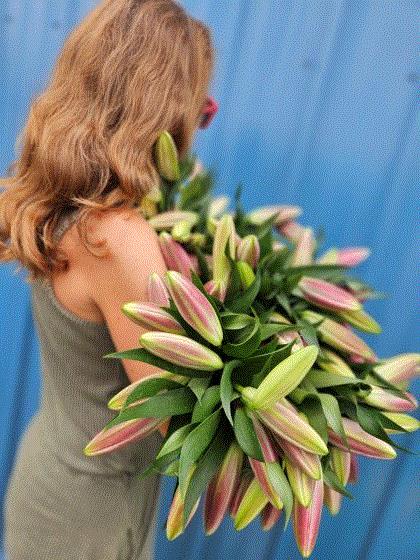
First armload of Dalian oriental lilies from our farm.
Tater and I are excited to start cutting our first crop of oriental lilies! Lilies might not be the first flower you think of when you hear “local flowers,” but hear me out: There may be a niche market in your community.
In my neck of the woods, a veteran lily grower recently closed his doors and left a tremendous void in the market. Since then, our florist friends have had a mix of merely acceptable to even poor experiences with lilies on the wholesale market. According to them, the challenge is it’s hard to tell when they order lilies from the wholesaler if they be usable that week or if they will be too green and take a week to open. Imagine getting a last-minute funeral and the lilies you ordered are as green as grass. It’s hard to make arrangements without flowers, and we heard this story time and time again from different clients. Tater and I are not sure why there is such variability in the timing of lilies on the wholesale market. But our florist loved getting local lilies each week that were ready to be used and are predictable.
Our florist customers begged and pleaded with me and Tater to try our hand at lilies; and after a year of careful calculation and consideration, we took the plunge! I have high hopes for this new enterprise and am hoping for excellent results. However, a wise grower once told me that it takes five years to really know and understand a crop. It also goes to show that it pays off to listen to your customers and entertain their requests. Who knows, maybe it’s worth asking your florist friends if local lilies would be valuable to them!
In this edition of Bloom Beat we’re recapping some of the exciting things we saw at Cultivate'25 and some conferences to put on your calendar.
With all that being said, let’s talk shop!

New Lisianthus Varieties from Cultivate'25
One of the best parts about going to Cultivate is seeing the breeders showcase the latest and greatest varieties that they are bringing to market. It’s exciting to be a cut flower farmer right now; there is new innovation everywhere you look— especially with lisianthus.
Japanese breeders Takii and Sakata are leading the charge for new lisianthus breeding. I saw these at show and I couldn’t wait to go home and show Tater and team Forget Me Not. The challenge is that some of these beauties won't be available for a few years. In my opinion, they are well worth the wait.
New Releases from Takii
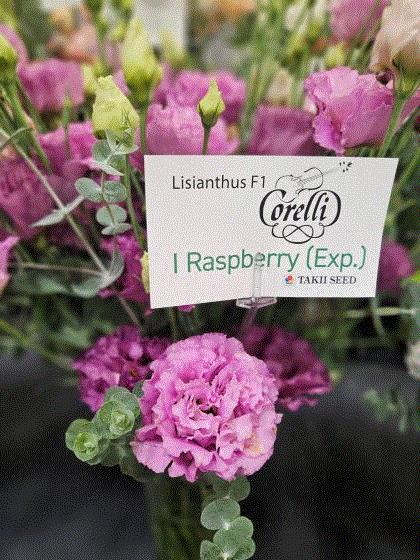
We grow a handful of Corelli Sugoi lisianthus varieties on our farm. They are strong workhorses—Tater and I love them! So I was really excited when I saw this Raspberry at the Takii booth. I think they will be a solid addition to our crop plan, once available. It will be nice to have a lisianthus in between pink and purple. Corelli Sugoi Raspberry is just that!
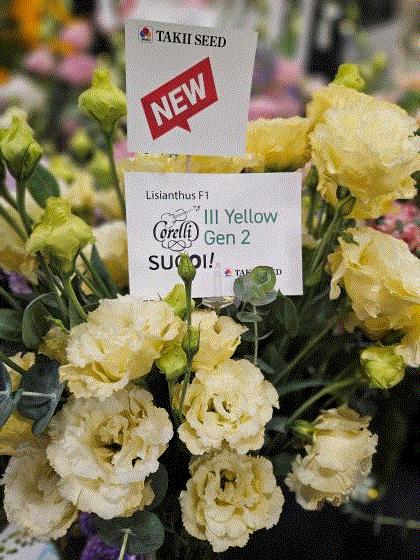
I am a sucker for buttercream. It's a hard color to find in the flower world and this improved Yellow Gen 2 in the Corelli Sugoi series is a stunner! The petals are extra-large and fluffy. This one isn't commercially available yet but she will be in about two years.
New Releases from Sakata
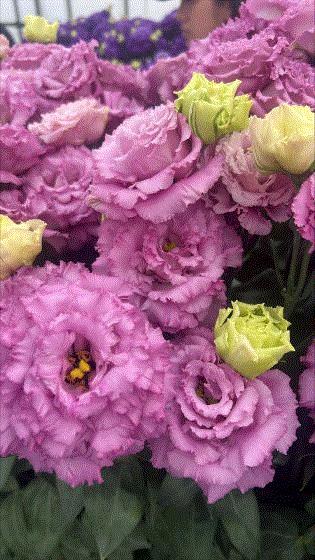
New Voyage variety still awaiting a name. How about Tater? Sakata photos by Greg Gabrels
This is my favorite new variety on the horizon. They didn't have samples at Cultivate since this baby is hot off the press! I saw multiple photos from different folks that attended the lisianthus trials in Japan and they were stunning!
Any guesses what this was called at the Sakata open house in Japan? Voyage Reddish, Brownish. Ha! I told the folks at Sakata they should name her Voyage Tater, but Voyage Mauve would be a second choice. Unfortunately, she won't be commercially available for a few years, and hopefully by then the marketing departments will come up with a great name. I think she will be worth the wait.
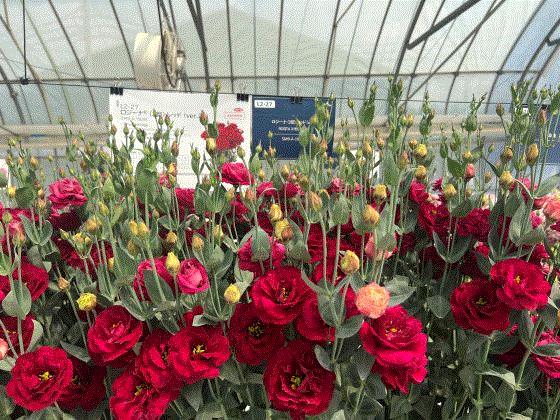
Rosita III Red in the Sakata trial greenhouse in Japan.
This is Rosita III Red! I have great news: This beauty IS commercially available! As you can see from the photo, this is a vibrant lipstick red that is perfect for both everyday arrangements and bold weddings. I'm usually partial to more subdued tones but this stunner stopped me in my tracks.

Jen Polanz’s Cut Flower Finds at Cultivate
Below is an excerpt from Green Profit managing editor Jen Polanz on some plant material suppliers for your to consider. If you are a looking to dip your toes in tulip production, be sure to check out Leo Berbee’s tulip medley package! Read on to learn more!
I got lured into the booth by adorable ice cream cones with dahlia blooms as the ice cream part (I may have been hungry), but I stayed for the new mixed tulip programs for cut flower growers. This wholesale bulb and bareroot perennial company carries specialty bulbs that work great for small cut flower farmers as well as retailers. They’ve been around since 1971 in the same location in Marysville, Ohio, and they have a Young Plants Division and an independent retail called Dutch Mill Greenhouse.
New for fall 2025 are the Tulip Medleys sold in smaller packs of 100, already pre-mixed with certain varieties. For orders placed before August 1 they offer pre-cooling. There are a number of different medleys, including Sweetheart Surprise (Salmon Prince, Hotspot, White Prince and Jumbo Pink); Berry and Bloom (Rosy Diamond and Blue Diamond) and Savannah Romance (Deep Purple Rock, Crunchy Cummins, Double Shake, Cabanna), among others.
Marketing Manager Bethany Anderson said the mixes were developed based on colors and on timing so they grow well and flower together.
'Kismet Kiwi' Echinacea Photo by Terra Nova Nursery
I spent some time with Chuck Pavlich, director of new product development at Terra Nova Nurseries, who walked me through their new introductions. One in particular stood out for cut flowers: Kismet Kiwi echinacea, which puts out unique-colored blooms on strong stems that are nearly 30 in. tall. The green hue comes from more chlorophyl in its petals (the picture Terra Nova has shows a lighter melon-green than what’s seen here—sometimes the lights in the convention center throw off colors).
Chuck told me he had been hearing interest from cut flower growers because it has about a 14-day vase life, and the green gets stronger as it ages. It also has a honey-like scent.

Charlie Hall’s State of the Industry Recap
Fellow editor Bill Calkins, of the e-newsletter Tech on Demand, recapped Dr. Charlie Hall’s Economic State of the Industry keynote address at Cultivate. Dr. Hall is a professor and Ellison Chair at Texas A&M and he is the industry go-to for forecasting consumer purchasing habits and economic outlooks. He has extensively researched and tracked cost of production for green industry producers for decades. It's no wonder Dr. Hall is American Hort’s chief economist. Trust me—this is a talk you want to pay attention to! You can listen to the full recording HERE. Here is Bill’s recap. (If you are not subscribed to Tech on Demand you really should! Bill shares timely and insightful grower tips each week that will improve your bottom line and keep you ahead of the competition.)
This year, amid all sorts of societal craziness, goofy weather, a shifting customer base and all the uncertainty we’re reminded of everywhere we turn for news, Dr. Hall’s message was positive. However, it was also fringed with caution and a bit of “wait and see.”
Although Dr. Hall ended with his 2026 recession outlook, I want to start with it. He shared all sort of indicators from various sources, discussed recent federal bills and decisions and concluded that recession in 2026 is NOT imminent. That’s good!
Backing up to the start of his talk, Dr. Hall took the standing-room-only audience through the past year for greenhouse producers, looking at total sales, profits, units sold and more. The numbers were excellent: 78% of growers reporting were up year-to-date compared with 2024; 98% of greenhouses were up compared to the pre-pandemic 2019 levels. Net profits YTD are up quite a bit as well. In terms of units, 50% are up and 50% are down YTD—meaning prices are up but the number of units going out the door are not up as much. Dr. Hall advised everyone to raise prices the past two years, so it seems like folks listened and acted.
When Dr. Hall turned his attention to retail sales (IGC and big box), the story was quite different. As reported by The Garden Center Group, revenue YTD was up only 0.3% and both transaction counts and customer counts were down. On the flip side, average sale was up almost 2%. Two of the three major box stores were up YTD but not by much. Growth continues for lawn and garden post-pandemic, and retailers are up quite a bit versus 2019, but the boom has plateaued. Dr. Hall showed regional breakouts for this data and there’s no doubt unfavorable spring weather played a huge role in limiting growth. Forecasts for consumer spending has been rising for the past few years but looks to be flattening.
Looking at supply and associated costs, Dr. Hall explained that there was a significant amount of buying (by businesses) that occurred before tariffs took effect and this inventory is in place and will be sold without major cost increases … but when it runs out, expect costs to go up because prices for your suppliers are going up. Dr. Hall said that the cost of goods (inputs) required to run green industry businesses can be expected to rise as little as 5.2% if tariffs don’t go too high or are reversed or as much as 9% if they go to plan and remain in place.
Now is a good time to link you to an article Dr. Hall wrote with our friend (and Ball Horticultural Company Market Research Manager) Dr. Marvin Miller that was published in the June issue of
GrowerTalks. In
PROPOSED TRADE POLICIES CREATE ECONOMIC INEFFICIENCIES, Drs. Hall and Miller dove deep into our supply chain (past and present) and how a strategic and nimble approach to buying across a global supply chain is necessary for today’s greenhouse producers. You should read this ASAP.
In the short term, Dr. Hall seemed positive and advised the audience to take advantage of what you can, now, because current government actions could benefit our businesses greatly. But of course, things are changing quickly so keep your finger on the pulse and be ready to pivot if necessary. He applauded our industry for learning a lot through the pandemic about the need to develop a diverse supply chain, our success keeping the almost 20 million new gardeners that walked through retail doors, and effectively raising prices.
Dr. Hall ended with two final takeaways/challenges for all green industry businesses: Manage capitol/stay agile and manage your relationships closely—with suppliers and customers.

Dr. Will Healy on Cut Lisianthus Production
In our last edition of Bloom Beat, Tater and I recapped my experience at Sunny Meadow’s farm tour. There was a lot of talk about lisianthus, and I was thrilled that Ball Hort's retired technical genius Dr. Will Healy emailed me to share his considerable expertise!
At the farm tour, there were discussions about how to succession-plant lisianthus. One of the challenges Midwest growers such as Sunny Meadows face is that lisianthus successions that are planted four to six weeks apart tend to overlap. Here are some thoughts from Dr. Healy on why some growers experience shorter stems:
- First off, it’s important to note why the stems are shorter. Does the stem have fewer nodes or shorter internodes?
- You must separate what is happening (fewer nodes or shorter internodes) to understand why stems are shorter (or longer).
Reasons for Shorter internodes:
What is the fertilizer program as a preplant and after planting? Stem length is governed by the amount of phosphorus (P) and ammonia/urea (NH4) that is applied pre- and post-planting. Internode stretch is controlled by the NH4+P amount, with more NH4+P resulting in longer the stems.
Old-time growers would incorporate treble superphosphate into the soil as a preplant to ensure adequate P in the soil after planting to promote stem stretch. They would then fertilize with a balanced fertilizer with NH4 early in the crop and switch to higher nitrate late in the crop to promote stem strength. Remember that lisianthus is a calcium-loving crop, so you need to make sure there is enough Ca in the feed late in the crop. I have talked to cut flower growers who have added 4+ in. to the stem length by just making sure that they have enough NH4+P in the early feed application.
How much NH4+P? If you use 20-10-20 at 200 ppm, you are applying at least 80 ppm NH4 and 40 ppm P with every irrigation, while 20-20-20 provides 140+ ppm NH4 and 80+ ppm P just due to the extra P and urea that may be in the fertilizer. Conversely, if you are using a 17-5-17 formulation at 200 ppm, then you are only adding 50 ppm NH4 and 25 ppm P with every irrigation. If you apply lower ppm N (i.e. 100 vs 200 ppm N) you are applying proportionally less NH4+P compared to 200 ppm N. During early season you may be applying MORE fertilizer during the life of the crop due to longer crop times and cool weather allowing more fertilizer uptake, while later in the summer the warm temperatures promote rapid growth and the plants don’t take up as much NH4+P due to the rapid growth—which equals shorter stems. Always check the fertilizer label to understand the amount of NH4 and P you are adding to maximize EARLY stem elongation. Application of high amounts of NH4+P late in the crop cycle creates weak stems!
Fewer nodes: Lisianthus are long-day plants. To determine if there is a difference in node number, take 10-20 stems and count the number of leaf pairs below the first flower branch. Compare the same variety from early and late plantings to see if there is a difference in node number. There is usually a variability of 1-2 nodes within a planting date due to the variability in plant development. A difference of 3 or more nodes between planting dates can create that many more internodes, which will contribute 4+ in. difference in final stem length. Figure that each node (internode) provides about 1-2 additional inches of height depending on fertilizer program (see above).
Plantings in June and early July experience the longest days of the year. Depending on where you live this can be 15+ hours. When the daylengths are <13 hours, flowering is delayed and node count increases. When the plants are exposed to 14+ hours of daylength, flower initiation is promoted and the number of nodes is reduced. If the young plant producer grows the plugs under >16 hours or uses night interruption lighting, then initiation is very rapid, resulting in a significantly reduced node count (very short stems).
Unfortunately, with sequential plantings in the late spring and early summer there is nothing you can do to minimize early induction (fewer nodes), since the daylength is what it is! Some growers may use 50% shadecloth for June and early July plants to reduce heat during early establishment, which can provide a “shorter” photoperiod, since the early morning and late afternoon light may be below the critical daylength to induce flowering.
Another strategy that some growers use is to plant the different flowering groups. The varieties in the different groups have different critical photoperiod when they are induced. The challenge is if you plant a “summer” variety too early in the season, flowering is very delayed, while planting a “spring” variety in the summer results in short stems. Unfortunately, the market is a wicked taskmaster and the most desired varieties may not be always available for the season you need to plant for harvest!
There is another interesting reason for short stems that may be involved in some limited cases. Most professional lisianthus plug producers have special techniques they use to prevent rosetting. These treatments also have the interesting side benefit of promoting longer stems. Always ask your plug producer if they are treating their plugs to prevent rosetting.
I hope that this helps clear up the confusion of why sequential planting is a struggle for growers. This is a common problem in a number of crops (think snapdragons) where floral induction is due to photoperiod.
Thanks, Will!
Rumor has it, there may be some exciting lisianthus research in the mill. Fingers crossed, as this will help all of us level up our lisianthus production. Until then, if you have any other tips and tricks on how to stagger lisianthus successions, Tater and I would love to hear from you.
DROP US A LINE!
2025 Northeast Greenhouse Conference and Expo

Anyone day dreaming of fall yet? If so, the
Northeast Greenhouse Conference and Expo is open for registration! The conference will be held at the Doubletree by Hilton Manchester Downtown Hotel and Expo Center in Manchester, New Hampshire, November 12 and 13. They have a rockstar lineup of the best floriculture experts in the business! This two-day conference is jam-packed with great sessions applicable to all floriculture producers. Remember, there are plenty of general floriculture principles that dovetail into cut flower production. You can check out the full lineup of talks
HERE.
Cut flower talks will be on Wednesday, November 12. If you are looking to level up your grower acumen, this is the conference for you. There is a robust range of technical topics ranging from water treatment, diagnosing nutrient disorders and manipulating daylength. Speakers include Ball Seed’s very own Dave Dowling, Dr. Roberto Lopez of Michigan State University and Dr. Garret Owen from Ohio State. I have it marked on my calendar, I hope you do, too!
Until next time,
Lindsay Daschner (and Tater)
Editor-at-Large—Bloom Beat
Owner—Forget-Me-Not Farms
This email was received by 6,250 of your fellow fresh-cut flower growers!
If you're interested in advertising in Bloom Beat, contact Kim Brown and she will hook you up!